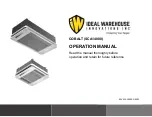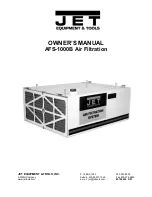
En-3
5. SELECTING THE MOUNTING POSITION
Decide the mounting position with the customer as follows:
5.1. Indoor unit
(1) Install the indoor unit level on a strong wall which is not subject to vibration.
(2) The inlet and outlet ports should not be obstructed : the air should be able to blow all
over the room.
(3) Install the unit a dedicated electrical branch circuit.
(4) Do not install the unit where it will be exposed to direct sunlight.
(5) Install the unit where connection to the outdoor unit is easy.
(6) Install the unit where the drain pipe can be easily installed.
(7) Take servicing, etc. into consideration and leave the spaces shown in “6.1. Installation
dimensions”. Also install the unit where the
fi
lter can be removed.
Correct initial installation location is important because it is dif
fi
cult to move the unit after it
is installed.
WARNING
Install the indoor unit where is capable to support the weight of the unit. Secure the
unit
fi
rmly so that the unit does not topple or fall.
CAUTION
Do not install the unit in the following areas:
• Area with high salt content, such as at the seaside. It will deteriorate metal parts, caus-
ing the parts to fail or the unit to leak water.
• Area
fi
lled with mineral oil or containing a large amount of splashed oil or steam, such
as a kitchen. It will deteriorate plastic parts, causing the parts to fail or the unit to leak
water.
• Area where is close to heat sources.
• Area that generates substances that adversely affect the equipment, such as sulfuric
gas, chlorine gas, acid, or alkali. It will cause the copper pipes and brazed joints to cor-
rode, which can cause refrigerant leakage.
• Area that can cause combustible gas to leak, contains suspended carbon
fi
bers or
fl
ammable dust, or volatile in
fl
ammables such as paint thinner or gasoline.
• If gas leaks and settles around the unit, it can cause a
fi
re.
• Area where animals may urinate on the unit or ammonia may be generated.
• Do not use the unit for special purposes, such as storing food, raising animals, grow-
ing plants, or preserving precision devices or art objects. It can degrade the quality of
the preserved or stored objects.
• Install the unit where drainage does not cause any trouble.
• Install the indoor unit, outdoor unit, branch box, power supply cable, connection cable,
and remote control cable at least 1 m away from a television or radio receivers. The
purpose of this is to prevent TV reception interference or radio noise.
(Even if they are installed more than 1 m apart, you could still receive noise under
some signal conditions.)
• If children under 10 years old may approach the unit, take preventive measures so that
they cannot reach the unit.
• Install the indoor unit on the wall where the height from the
fl
oor is more than 1.8 m.
6. INSTALLATION WORK
CAUTION
• Do not hit or push the human sensor. This may lead to damage or malfunction.
• Do not touch the human sensor. Any scratches or dirt may lead to incorrect detection.
• Do not place large objects near the human sensor. Also keep heating units outside the
sensor’s detection area.
Detection range of the human sensor is as follows.
Vertical angle 90° (Side view)
90°
50°
50°
7 m
7 m
Horizontal angle 100° (Top view)
6.1. Installation dimensions
(Wall cap)
1.5 m or more
70 mm or more
88 mm or more
Wall hook bracket
140 mm
or more
1.8 m or more
Remote
controller
Remote
controller
holder
Tapping screws
(small, accessories)
6.2. Indoor unit piping direction
The piping can be connected in the 7 directions in the
fi
gure. When the piping is con-
nected in direction (B), (C), (D) or (E), cut along the piping groove in the side of the front
panel with a hacksaw.
(B) Right
outlet
(A) Rear
outlet
(C) Bottom
outlet
(D) Left bottom
outlet
(E) Left
outlet
(Rear)
(F) Centre
outlet
(G) Left rear
outlet
6.3. Cutting the hole in the wall for the connecting piping
(1) Cut a 80 mm diameter hole in the wall at the position shown in the following.
(2) Cut the hole so that the outside end is lower (5 to 10 mm) than the inside end.
(3) Always align the center of the wall hole. If misaligned, water leakage will occur.
(4) Cut the wall pipe to match the wall thickness, stick it into the wall cap, fasten the cap with
vinyl tape, and stick the pipe through the hole.
(5) For left piping and right piping, cut the hole a little lower so that drain water will
fl
ow
freely.
Wall hook bracket
Centering marks
Lower
Lower
10 mm
or more
80 mm hole
10 mm
or more
80 mm hole
Fasten with vinyl tape
5~10 mm
Wall pipe
(Locally purchased)
Wall cap
(Locally purchased)
(Inside)
(Outside)
Wall
WARNING
Always use the wall pipe. If the wall pipe is not used, the cable that is connected between
the indoor unit and the outdoor unit may touch metal, and cause an electric discharge.
9387082050-02_IM.indb 3
9387082050-02_IM.indb 3
13/3/2018 PM 5:00:25
13/3/2018 PM 5:00:25






























